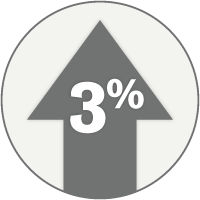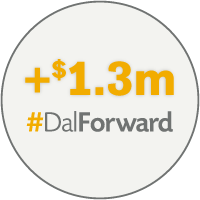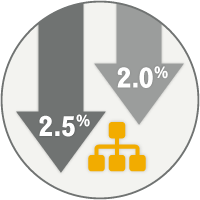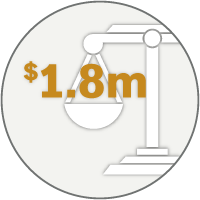Dalhousie’s Budget Advisory Committee (BAC) has released its draft operating budget plan for 2015-16, signaling the next phase of budget season at the university.
The report outlines the university’s anticipated revenue and expenditures for the upcoming year, and makes recommendations on items such as tuition, fees and proposed adjustments to Faculty and unit budgets.
The draft operating budget plan is also an opportunity for the Dal community to provide further feedback on the recommendations before the committee submits its final recommendations to the president and the Board of Governors in April. Tuition and fees are approved at the April Board meeting — so they can be implemented in time for the upcoming academic year — and the final budget is then approved in June.
As we have done for the past two years, we’ve prepared a Dal News “BACgrounder” that looks into the BAC process, the report’s recommendations and their impact in the Dalhousie community. If you’d like to be part of the consultation process, check out the full details at the bottom of this story.
- Read: The Budget Advisory Committee Draft Operating Budget Plan, 2015-16 [PDF]
- Read: Student tuition and fee recommendations, 2015-16 [PDF]
 Who is the Budget Advisory Committee?
Who is the Budget Advisory Committee?
The BAC advises the president on budgetary issues. Chaired by Carolyn Watters, provost and vice-president academic, the group also includes the vice-president finance and administration, one dean, two faculty members, two students and a staff member. Members are selected based on their knowledge and experience, and not as representatives of specific interests.
Planning for the 2015-16 budget report began with the BAC’s initial consultation with stakeholders in the fall. Faculties and service units were asked to answer specific questions about their budget pressures and their capacity to boost revenues or lower expenditures. Deans made presentations to the BAC to detail the financial situations of their respective faculties. The DSU, Facilities Management, Libraries and various student groups also presented to the BAC. Over the past few weeks, the student members of the BAC have additionally surveyed Dal’s student societies for their input.
As in previous years, the BAC report does not include the Agricultural Campus, which is funded under a separate agreement with the Province of Nova Scotia. Its budget for 2015-16 is, therefore, considered separately.
 The budget must be balanced
The budget must be balanced
The Board of Governors requires that the university budget be balanced. Any gap between revenue (how much money Dal brings in) and expenditures (how much money Dal spends) must be addressed by increasing revenue, reducing expenditures or some combination of both. Last year, Dal’s operating budget was balanced with revenues and expenditures of $354 million
The university’s largest source of revenue — its provincial operating grant — is set each year by the province (see below). If the provincial operating grant fails to keep pace with inflationary or other costs, that leaves, generally, only two ways for the university to balance the operating budget: increasing revenue (typically through enrolling more students and/or raising tuition fees) and reducing spending.
 Government funding: Another modest increase assumed
Government funding: Another modest increase assumed
Almost 90% of Dal’s operating funds come from just two sources: the provincial operating grant and tuition revenue.
Of these, the larger of the two is the provincial operating grant, which makes up over half of the university’s total operating revenue (51.3%). Last year the provincial operating grant was increased by a modest 1%, but that increase followed three years of cuts. Overall, Dal’s operating grant has seen a net decrease of 9% over the past four years.
The provincial government has not yet confirmed Dalhousie’s operating grant for 2015-16. The BAC has assumed another 1% increase in the operating grant for this upcoming year. This would add $1.6 million to the university’s revenue.
 Tuition and fees: A proposed 3% increase
Tuition and fees: A proposed 3% increase
While an increase to the provincial operating grant would be welcome news, the assumed 1% increase falls well short of addressing Dal’s increasing operating expenses (see below). This leaves two ways the university can balance the budget: generating more revenue and finding cost savings.
In recent years, the Government of Nova Scotia has capped tuition increases for most programs at 3%. A government Tuition Policy Review Working Group is currently considering tuition fee regulation going forward, but its report is not yet available. The BAC is assuming for this upcoming year that the 3% cap will remain in place.
Dal’s enrolment increases in recent years have helped reduce the need for deeper budget reductions. This year, the BAC is projecting an enrolment increase (based on preliminary recruitment figures) of 180 students.
Still, the BAC proposes that tuition increases will need to be part of the mix in balancing the budget. Its recommendation is for a 3% increase in most programs and to the international differential fee. This will bring in an additional $3.6 million to the budget.
The BAC is not recommending any further increases to tuition and fees in Medicine, Law, Dentistry or international differentials (where tuition is not capped) beyond the phased tuition increases for Dentistry and Medicine which began last year.
The BAC is also recommending a 3% increase in the auxiliary fee for facilities renewal paid by students, from $81.90 to $84.35 per term. Additional proposed changes to auxiliary and ancillary fees across the university are detailed and further explained in the tuition and fee recommendations report, emailed to all students this week.
 Compensation and other rising costs
Compensation and other rising costs
As noted, the assumed increase to Dal’s provincial operating grant won’t be enough to cover rising operating expenses. During the past four years, while Dal’s provincial operating grant has decreased by 9%, expenditures at Dalhousie have risen by 10.8%. In 2015-16, the BAC projects university expenditures to continue to increase, this year by $13.5 million.
Why is this the case? Compensation for Dal faculty and staff is the largest expense in the university’s budget; under the draft budget plan, compensation (salary, pension, benefits) accounts for 75.8% of all expenditures for next year. This amount rises each year due to cost-of-living and other regular increases. In addition, collective agreements with the bargaining units representing Dal’s employees expired last July, and with new agreements finalized or in the process of collective bargaining, the BAC has provided for an increase of $9.9 million in salary, pension and benefit expenditures.
Other increases
• $1.2 million (7.2%) for utilities: energy, water, taxes and insurance
• $133,000 (1.9%) for library acquisitions
• $500,000 (3.0%) for renewal of existing facilities
With the BAC assuming only $1.6 million in new funds from the provincial government, Dalhousie must look to tuition revenue and cost savings to balance the budget.
 Strategic priorities and facilities renewal: Increasing support
Strategic priorities and facilities renewal: Increasing support
There are two other areas where the BAC is specifically targeting increased spending. One is to support strategic initiatives outlined in Inspiration and Impact: Dalhousie’s Strategic Direction. The BAC believes these priorities — agreed upon by Senate and the Board following broad campus consultation during the 100 Days of Listening — are vital to Dal’s long-term future and need to be supported accordingly. Therefore, the BAC proposes to first restore the strategic initiatives budget to last year’s level of $2 million and then to increase the fund by $700,000, for a total fund of $2.7 million.
The BAC also supports increasing funding for facilities renewal to continue to address significant deficits in the university’s physical infrastructure. (Dal’s building conditions are the second worst among U15 universities, with a deferred maintenance backlog of approximately $283 million.) Guided by the recommendations of the Board’s Long Term Financial Planning Committee, the BAC proposes increasing Dal’s facilities renewal investment by $500,000 in 2015-16, the same amount it was increased last year.
 Finding cost savings in Faculties and service units
Finding cost savings in Faculties and service units
Tuition increases alone can’t balance the budget. As has been the case in recent years, reductions will be required to Faculty and service unit budgets. Rather than mandate specific reductions within Faculties and service units, the BAC recommends budget changes, as a percentage, applied across the university. From the Faculty of Engineering to Facilities Management to Human Resources, each unit must apply these changes in a manner consistent with their needs and objectives.
The BAC report identifies that Faculty and service unit budgets need to be reduced by a total amount of $5.8 million. To achieve this, the draft budget plan calls for a 2.5% decrease for Faculty budgets and a 2% decrease for service units.
In assessing the relative opportunities for cost savings in Faculties and service units, the BAC takes into account the fact that Faculties can generate revenue, can recognize greater savings through the replacement of departing senior faculty members with junior members (owing to differences in salary scales between faculty and staff) and the ability of Faculties to gain revenue through enrolment-related budget allocation (ERBA), an internal funding formula based on enrolment numbers.
 Limiting the reliance on financial reserves
Limiting the reliance on financial reserves
Last year, Dal set aside $3.8 million in reserve funds from higher-than-projected enrolment in prior years to balance the budget. Enrolment was higher than expected, meaning only $2.5 million of these funds were actually required.
The BAC emphasizes that reserve funds cannot be considered an ongoing budget resource and that using them to balance the budget is not a sustainable long-term option. For that reason, the BAC recommended a three-year scaling back of the use of reserve funds starting last year.
For this 2015-16, the BAC recommends applying $1.8 million in reserve funds to help close the budget gap.
 Have your say
Have your say
The BAC welcomes the thoughts of Dal faculty, students and staff before it submits its final recommendations to the president and the Board of Governors in April. Here’s how you can weigh in:
• If you’d like to provide written feedback and input, email BAC@dal.ca
• There are three information/consultation sessions for students to provide feedback on the draft Budget Advisory Committee report and the proposed fees for 2015-16.
March 10, 4-5 p.m. — B400, Killam Library Basement, Studley Campus; videoconferenced to President’s Boardroom, Cumming Hall, Agricultural Campus
March 20, 4:30-5:30 p.m. (rescheduled from March 18 due to weather) — Auditorium HA19, Medjuck Building (H Building), Sexton Campus
March 31, 3:30-4:30 p.m. — Room 303, Student Union Building, Studley Campus. This session will be livestreamed video the DSU YouTube channel.

